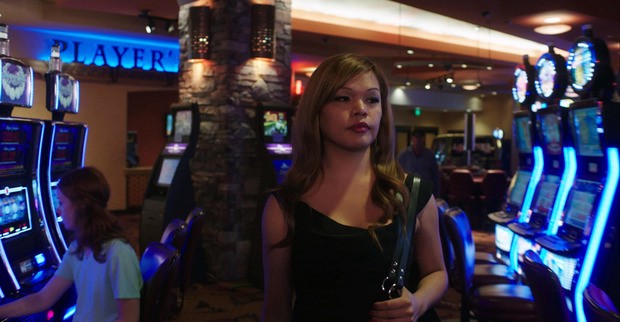Writer-director Sydney
Freeland’s feature debut, Drunktown’s Finest, was shot
against New Mexico’s mesmerizing landscape and explores life on the reservation
in the 21st century. The film premiered at the Sundance Film
Festival in January and was included in the 2014 Sundance London program.
Could you tell us in a few words what your
film, Drunktown’s Finest, is about? I know it’s a very personal story
for you.
My film is
a coming-of-age story about three young Native Americans who want to escape the
reservation: a rebellious father-to-be, a promiscuous transsexual character, and an adopted girl who has been raised by a Christian family and wants to
reconnect with her biological family.
I am Native
American and I was born and raised on a reservation in the Southwestern United
States. Filmmaking is not something that people do on the reservation — it’s
more about traditional, classical arts like painting, drawing, silver-smithing,
weaving, and pottery. That’s what I grew up with and I originally went to
college to study painting and drawing. While I was there, I was exposed to other
mediums like photography, computer animation, writing, screenwriting and,
ultimately, filmmaking. It was my last semester of undergraduate studies when I
took a film class — wow, that was what I wanted to do. It was such a strange
concept to me that people made movies. It was mind-blowing. People get paid to
do this?
There’s Ricciotto Canudo’s concept of film as
the seventh art, encompassing all of the traditional art forms. As a Native
American filmmaker, you’re breaking tradition insofar as you’re bringing this
seventh art into the realm of the reservation in order to tell a story that is
also about breaking tradition, reversing stereotypes, and escaping one’s
circumstances. In your experiences as a Native American woman filmmaker, can
you talk a little about breaking traditions and breaching expectations?
If I look
at myself on paper, I’m a minority of a minority of a minority. But for whatever
reason, I’ve never really thought about it. I have a desire to tell
stories through film, and I’ll do whatever it takes to do that. There are people
who are surprised when I show up because I don’t look like the person they
expected to see. I don’t let it worry me as I know we’re all just working
together to tell a story.
In terms of working together, a big difference
between traditional arts and crafts of Native American culture and filmmaking
is that the former is individualized and private, whereas filmmaking is
collaborative and public insofar as it requires an audience. What does it
mean to be an artist in the private vs the public sphere?
The thing
that initially attracted me to filmmaking is the combination of the art forms
and the collaborative nature of the medium. I love working with people. I love
the isolation of the writing but I also enjoy the chaos, excitement, and
pressure of being on set.
There is
some footage in the film that I shot entirely by myself, walking around the
reservation. I don’t think this film could have been made without the
democratization of technology, the availability of such inexpensive and
effective equipment, and the power to just go out and shoot material. That freedom
has helped me grow as a storyteller and as a filmmaker.
Have you thought about your next steps?
I’m working
on a sci-fi time travel film right now — quite a different topic from Drunktown’s
Finest! That’s a feature I’m writing and I’ll direct. I also work for a
production company in Los Angeles and we’re filming a music documentary. Between
those two projects I’m definitely keeping busy, but Sundance and this film have
opened up some doors and I’m thinking carefully about what to do next. My hope
is to continue as a writer/director — I love the complement of the two.
Do you have any advice for women directors and
first time directors?
Learn to
accept rejection. Your project will be accepted when it is good enough and the
rejections will only force you to make your project better. Every time you get
a rejection, it’s an opportunity to go back to the project and improve it. My
goal is to be the best writer I can be, the best director I can be — you have
to have that mindset if you want to succeed. I try not to think of myself as a
woman director or as a Native American director, just a director.






